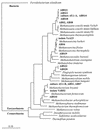Diversity and structure of the methanogenic community in anoxic rice paddy soil microcosms as examined by cultivation and direct 16S rRNA gene sequence retrieval
- PMID: 9501436
- PMCID: PMC106352
- DOI: 10.1128/AEM.64.3.960-969.1998
Diversity and structure of the methanogenic community in anoxic rice paddy soil microcosms as examined by cultivation and direct 16S rRNA gene sequence retrieval
Abstract
A dual approach consisting of cultivation and molecular retrieval of partial archaeal 16S rRNA genes was carried out to characterize the diversity and structure of the methanogenic community inhabiting the anoxic bulk soil of flooded rice microcosms. The molecular approach identified four groups of known methanogens. Three environmental sequences clustered with Methanobacterium bryantii and Methanobacterium formicicum, six were closely related but not identical to those of strains of Methanosaeta concilii, two grouped with members of the genus Methanosarcina, and two were related to the methanogenic endosymbiont of Plagiopyla nasuta. The cultivation approach via most-probable-number counts with a subsample of the same soil as an inoculum yielded cell numbers of up to 10(7) per g of dry soil for the H2-CO2-utilizing methanogens and of up to 10(6) for the acetate-utilizing methanogens. Strain VeH52, isolated from the terminal positive dilution on H2-CO2, grouped within the phylogenetic radiation characterized by M. bryantii and M. formicicum and the environmental sequences of the Methanobacterium-like group. A consortium of two distinct methanogens grew in the terminal positive culture on acetate. These two organisms showed absolute 16S rRNA gene identities with environmental sequences of the novel Methanosaeta-like group and the Methanobacterium-like group. Methanosarcina spp. were identified only in the less-dilute levels of the same dilution series on acetate. These data correlate well with acetate concentrations of about 11 microM in the pore water of this rice paddy soil. These concentrations are too low for the growth of known Methanosarcina spp. but are at the acetate utilization threshold of Methanosaeta spp. Thus, our data indicated Methanosaeta spp. and Methanobacterium spp. to be the dominant methanogenic groups in the anoxic rice soil, whereas Methanosarcina spp. appeared to be less abundant.
Figures



References
-
- Achtnich C, Schuhmann A, Wind T, Conrad R. Role of interspecies H2 transfer to sulfate and ferric iron-reducing bacteria in acetate consumption in anoxic paddy soil. FEMS Microbiol Ecol. 1995;16:61–70.
-
- Asakawa S, Akagawa-Matsushita M, Morii H, Koga Y, Hayano K. Characterization of Methanosarcina mazeii TMA isolated from a paddy field soil. Curr Microbiol. 1995;31:34–38.
-
- Asakawa S, Morii H, Akagawa-Matsushita M, Koga Y, Hayano K. Characterization of Methanobrevibacter arboriphilicus SA isolated from a paddy field soil and DNA-DNA hybridization among M. arboriphilicus strains. Int J Syst Bacteriol. 1993;43:683–686.
-
- Beliaeff B, Mary J Y. The “most probable number” estimate and its confidence limits. Water Res. 1993;27:799–805.
Publication types
MeSH terms
Substances
Associated data
- Actions
- Actions
- Actions
- Actions
- Actions
- Actions
- Actions
- Actions
- Actions
- Actions
- Actions
- Actions
- Actions
- Actions
- Actions
- Actions
- Actions
- Actions
LinkOut - more resources
Full Text Sources
Other Literature Sources
Molecular Biology Databases
Miscellaneous

